#igi art
Explore tagged Tumblr posts
Text




finally switched hands.
68 notes
·
View notes
Text

#guram dochanashvili#Igi#quotes#georgian literature#love quotes#woman on my mind#art#thoughts#dreams#world in my mind#good mood#good vibe#good music
6 notes
·
View notes
Text



i wanted more igi specific drawings and doodles to post this but oh well. kuiberyll be upon ye + DENIMA my favorite wonderful girl get her OUT of there
@intergalactic-idiots is da name of da game
#shinys art#artists on tumblr#digital art#fanart#eyestrain#eyestrain tw#eyestrain cw#song i took the words from for the last one is lovers rock by tv girl#for denima i feel like the. um. she is my comfort character and seeing her in an environment like that stresses me out#so i will be relinquishing her and i expect to see her in boxes Type Meme#anyway yeah take my igi sketches n drawing byeee
9 notes
·
View notes
Text

Igi Lola Ayedun
Left a grave to admire And as we reach for the sky, 2023
Oil and gold wax on concrete and mortar pigmented with lapis lazuli, indigo, pearl, and gold powder
10 1/5 × 6 3/10 in | 26 × 16 cm
6 notes
·
View notes
Text

#how it feels to dislike the writing in prod*igy season 2#season 1 is peak but they ruined it with some seriously poor choices in season 2#I enjoy some qualities such as art/music and little bits of dialog from stand alone scenes#the voice acting is great considering#but the central plot choices in season 2? hell fucking naw.#once you start to look at it critically it collapses like a house of cards#maybe next time dont cast people based on nepotism and just write for the characters you already included#over the toxic positivity surrounding it#season 1 is good and it's the only reason 2 has any merit#9/10 season where?
4 notes
·
View notes
Text
It's 2am, no one will see this, and I don't care I'm so proud of how fast I threw this out
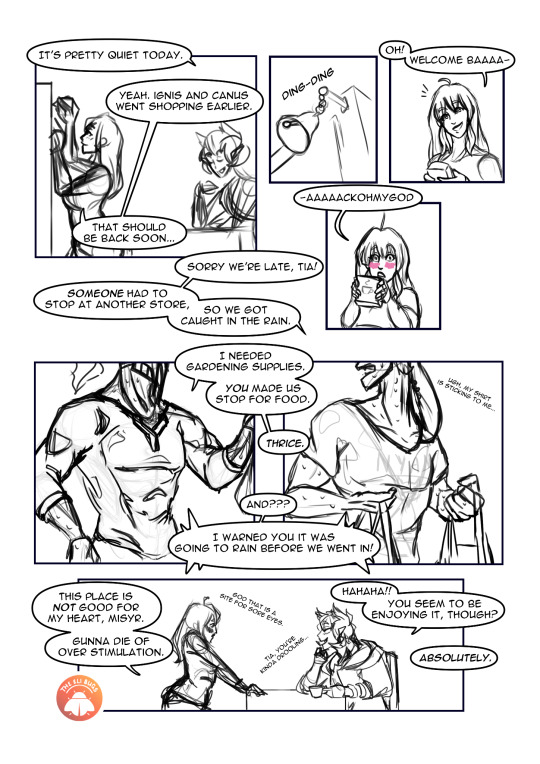
#cafe enchante#cafe enchante art#canus#canus espada#canus cafe enchante#ignis#igis carbunculus#ignis cafe enchante#misyr#misyr rex#misyr alex#misyr cafe enchante#art#comics#comic art#wip#kinda?#eli draws a thing
19 notes
·
View notes
Text
Old HMMS,IGI concept art and loglines

And there is my bunch of concept art for "Hand Me My Shovel, I'm Going In!" I love making funny cartoons (gonna share them soon???) and i have many ideas for a loooot of songs 🤪 And Will? He is a DREAM for an animator, the way he uses his voice is incredible and he is so expressive and it's hard to resist from imagining a cool amv with fav characters or Will himself. So i have one in my mind too!

I imagine something between looney-tunes stuff, EDGY FACES 😺🙏 (cartoonish and ironic level of edgy) anddd some psychologically-grotesqually-timburtonly serious scenes what brings the story into this piece! Prob imagining him digging into unknown grave, but he never reaches the coffin there, so he digs down and down and becoming more and more obsessed and insane..... + Some flashbacks about his past life + all that serious stuff that lies beneath the cartoonishness about addictions and social degradation ☠️ + in the end he finds a coffin and surprise surprise its his own ⚰️
Sorry for my silly speaking! English is not my mother language + i just dont see much sense in being very serious about non existing animation
Anyway! So this one is like an one big metaphor on self destruction..? You know diggin your own grave and stuff

This piece is for that dramatic part near the end of the song. I imagine endless space filled with empty glasses pills and uhhh other terrible things. The character (Which is sorta like Will's songsona for this concrete song, based on WW's appearance AND lirycs of the song for his character and story)
Also there is a scene in the end when he gets absolutely nuts so he digs dirt with his fingers..... Imagine the long long tunnel above him and when i mean long i mean looney tunes level of exaggeration


Oh there is a lot of world plays I'm not sure i can translate 0.o.... these are pretty old !!! Explanation for left bottom corner its a joke based on lines about blind pickpocket
That's all!!!! Sorry for longread
515 notes
·
View notes
Text
Well, um, hiya☆
I've come to life a little here and brought you some interesting features in the characters' spoken language
To begin with, let's look at the male trio of main characters: Naruhodō, Mitsurugi, Odoroki (Wright, Edgeworth, Justice)
Some people know it, some don't, but in Japanese there are many options for how to refer to yourself, i.e. "I" can be said with different pronouns and they are all ranked by gender (there are also gender-neutral ones) and the level of politeness.
The first one we have is Naruhodō.
He always, regardless of the situation, uses the pronoun "boku" (ぼく) in relation to himself.
僕 (ぼく)
僕 (boku) is a first-person pronoun often associated with male speakers. It has earnest, polite, cultured connotations. Overall, 僕 (boku) has a softer, less aggressive than 俺 (ore), another common pronoun with masculine connotations.
Naruhodō uses it both in the first trilogy, when he is 24-26 years old, and after the 7-year gap, when he is 33-35. It doesn't matter if he is in the courtroom or talking to friends - he always uses "boku".

言わずと知れた、ぼくだ。 若手実力派弁護士として、 今年で3年目に入る。
Iwazu to shireta, bokuda. Wakate jitsuryoku-ha bengoshi to shite, kotoshi de 3-nen menihairu.
It goes without saying that it is me. I am a young and talented lawyer, and this is my third year in the industry.
___________________________________________
ぼく・・・・今、弁護士を 目指して、勉強しているんです。
boku ima, bengoshi o mezashite, benkyō shite iru ndesu.
I'm studying to become a lawyer.
___________________________________________
いいや。ぼくは、 大学は芸術学部だったからね。
Ī ya. Boku wa, daigaku wa geijutsu gakubudattakara ne.
No. I entered the arts department at the university.
___________________________________________
When addressing someone, Naruhodo uses pronoun "omae".
お前 (おまえ)
お前 is a second-person pronoun that's masculine and rough — it's often used for cussing! It could also be a way to show affection to close friends, partners, and family in a very casual manner.
It is curious that he only addresses Mitsurugi this way, while he addresses the others (Mayoi, Odoroki, etc.) by name + suffix (Mayoi-chan, Odoroki-kun).

もしかして、おまえ・・・・ やったんじゃないの?
Moshikashite, omae yatta n janai no?
Maybe you... did it?
___________________________________________
そういうおまえだって、捜査の時は 証拠品をつきつけまくってたとか。
Sōiu omae datte, sōsa no toki wa shōko-hin o tsukitsuke makutteta to ka.
Even you, who is like that, apparently presented a lot of evidence during the investigation.
___________________________________________
おはよう。思ったより早かったねえ ・・・・オドロキくん。
Ohayō. Omottayori hayakatta ne e Odoroki-kun.
Good morning. It was earlier than I thought... Odoroki-kun.
___________________________________________
Next up we have Mitsurugi.
Mr. Politeness uses the pronoun "watashi" when referring to himself.
私 (わたし/わたくし)
わたし (watashi) is quite a common first-person pronoun as it's used regardless of gender, and both in casual and formal situations.It also has a certain elegant, sophisticated feel to it.
It also does not change over time, and is used by him both at 24-26 and at 34-35 years old.
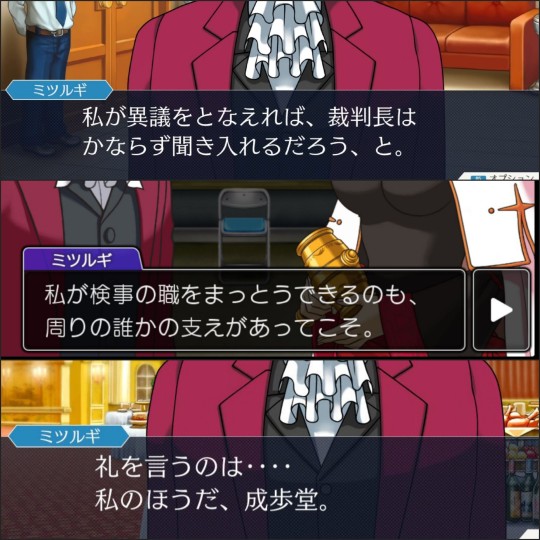
私が異議をとなえれば、裁判長は かならず聞き入れるだろう、と。
Watashi ga igi o tonaereba, saiban-chō wa kanarazu kikiirerudarou, to.
If I raised an objection, the judge would certainly listen.
___________________________________________
私が検事の職をまっとうできるのも、 周りの誰かの支えがあってこそ。
Watashi ga kenji no shoku o mattō dekiru no mo, mawari no dareka no sasae ga atte koso.
It is only thanks to the support of those around me that I am able to carry out my duties as a prosecutor.
___________________________________________
礼を言うのは・・・・ 私のほうだ、成歩堂。
rei o iu no wa watashi no hōda, Naruhodō.
I should be the one to thank you, Naruhodo.
___________________________________________
But he has a special attitude towards the informal address "you". And by the way, it depends on the situation Mitsurugi is in, and not on who he is addressing.
Because he uses at least 4 (maybe more, I couldn't catch them all) options of address!
The first is "omae". We have already discussed it, so I will not repeat myself. But the situation in which it is used is when Mitsurugi tries to be cheeky, when he makes fun of others (most often, of course, Naruhodō)
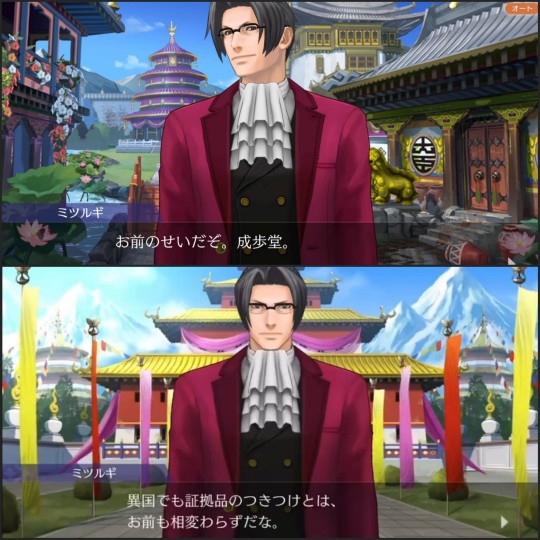
お前のせいだぞ。成歩堂。
Omae no seida zo. Naruhodō.
It's your fault, Naruhodō.
___________________________________________
異国でも証拠品のつきつけとは、
お前も相変わらずだな。
Ikoku demo shōko-hin no tsukitsuke to wa, omae mo aikawarazuda na.
You're still the same, presenting evidence even in a foreign country.
___________________________________________
Next, the address "kimi".
君 (きみ/キミ)
君 (kimi) is a second-person pronoun with various nuances. Some dictionaries define 君 as a pronoun you can use in a friendly way towards someone of equal or lower status. These days, however, the way 君 is perceived varies quite a bit from person to person.
Outside of hierarchical situations like the workplace, 君 is used a lot to sound literary or poetic.

成歩堂。折り入って キミに頼みたいことがある。
Naruhodō. Oriitte kimi ni tanomitai koto ga aru.
Naruhodō. There's something I'd like to ask you.
___________________________________________
キミのいない法曹界は 平和そのものだったよ。
Kimi no inai hōsōkai wa heiwa sonomonodatta yo.
The legal profession would be at peace without you.
___________________________________________
いや。・・・・・・・・だが、結局 キミの力にはなれなかった。
Īya. Daga, kekkyoku kimi no chikara ni hanarenakatta.
No... But in the end, I couldn't be of any help to you.
In the example, Mitsurugi asks Naruhodō for help, so I don't think it's a hierarchy thing. It's more of an equal thing. (Correct me if I'm wrong)
___________________________________________
And then comes the most epic part. Kisama.
貴様 (きさま/キサマ)
貴様 (kisama) is a second-person pronoun that's masculine and rough, it's often in combination with vulgar language!
Although it's associated with masculinity, that doesn't mean it's a pronoun only for men. Even if you don't use 貴様 regularly, it's a great way of expressing your anger.
貴様 can also be a way to show affection in a very casual way towards close friends, partners, and family. In this case, the above example would be playful, rather than showing genuine anger.
Mitsurugi uses it when he gets angry (usually in the courtroom) and sometimes in relation to friends. So, the area of application is justified by its purpose as a pronoun.
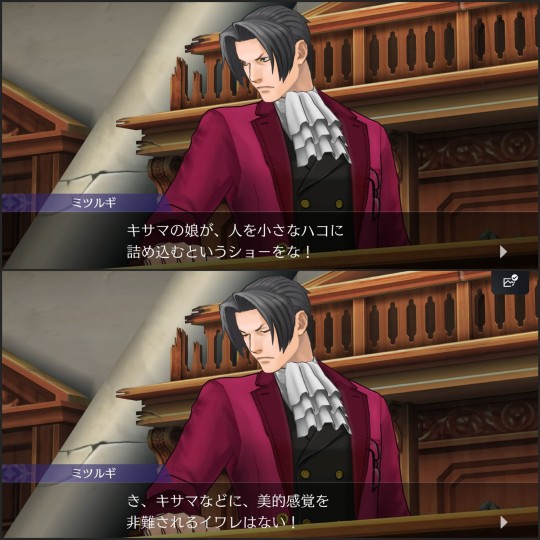
キサマの娘が、人を小さなハコに 詰め込むというショーをな!
Kisama no musume ga, hito o chīsana Hako ni tsumekomu to iu shō o na!
Your daughter puts people into tiny boxes in a show!
___________________________________________
き、キサマなどに、美的感覚を 非難されるイワレはない!
kisama nado ni, biteki kankaku o hinan sa reru iware wanai!
You have no right to criticize aesthetic sense!
And the last one - addressing by name + suffix or without suffix (Mayoi-kun, Naruhodō)
___________________________________________
Next - Odoroki Hosuke (Apollo Justice)
He's a real manly man, haha. He always uses the pronoun "ore".
俺 (おれ/オレ)
俺 (ore) is a first-person pronoun with a strong masculine feel. It sounds "manly" and less gentle than 僕. 俺 is also a pretty casual pronoun and can be seen as vulgar, especially when used in formal situations. In order to use 俺 naturally, the speech style also needs to match the manliness of 俺.
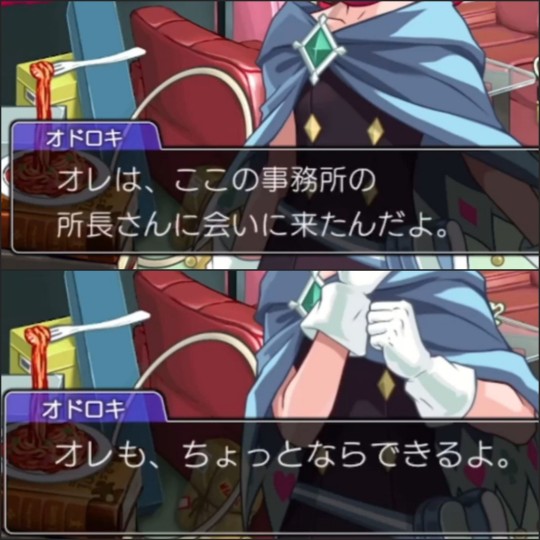
オレは、ここの事務所の 所長さんに会いに来たんだよ。
ore wa, koko no jimusho no shochō-san ni ai ni kita nda yo.
I came here to see the director of this office.
___________________________________________
オレも、ちょっとならできるよ。
A odoroki ore mo, chottonara dekiru yo.
I can do it a little bit magic too.
___________________________________________
But he doesn't bother with addressing others, and always addresses them by name + suffix (Naruhodo-san, Minuki-chan, Garyu-kenji, Mitsurugi-kenji)
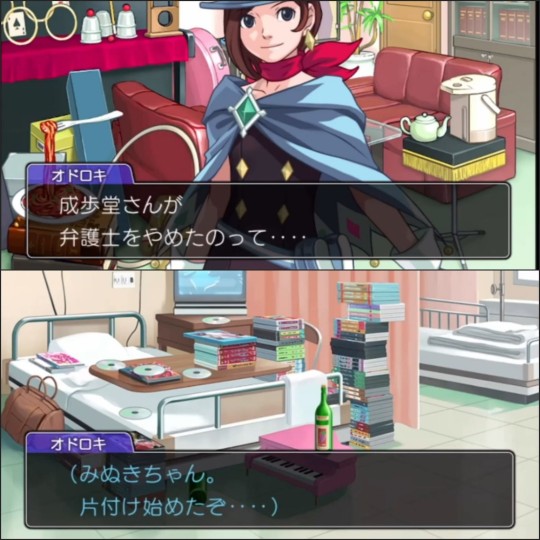
成歩堂さんが 弁護士をやめたのって・・・・
Naruhodō-san ga bengoshi o yameta notte
Naruhodō-san quit being a lawyer...
___________________________________________
(みぬきちゃん。 片付け始めたぞ・・・・)
(Minuki-chan. Katadzuke hajimeta zo)
(Minuki-chan, you're starting to clean up...)
___________________________________________
P.S.
I hope this will clarify the characters a bit and give you a new perspective on them.
One day, I'll do the same with the main female characters (because it takes a lot of time, but I bless those who post screen recordings and screenshots, thanks to them I can quickly find the right moment).
There may be errors and typos, don't be afraid to point them out to me
#ace attorney#gyakuten saiban#naruhodou ryuuichi#phoenix wright#miles edgeworth#mitsurugi reiji#odoroki housuke#apollo justice#omg i did this#time to rest a little#😴#naruhodo ryuichi
473 notes
·
View notes
Text
tegnap mondta egy vendég, hogy el akart vinni az egyik szomszéd intézménybe egy jeles street art művész megnyitójára a héten. és kénytelen voltam elmondani neki, hogy egyrészt becsülöm és tisztelem a szomszédokat, de még az autisztikus személyiségjegyeimen keresztül is átjön, hogy a közös eseményeken soha nem jönnek oda hozzám köszönni, és az első találkozásnál velem szemben definiálták a helyüket és olyan gőggel és lenézéssel beszéltek rólam és a terveimről, hogy arra jutottam, hogy teljes nélkülük is az életem.
másrészt a street art nekem egy icipicit többet jelent egy divatnál. nagy levegő és vállalom leírva is. nekem a street art a művészet demokratizálódását is jelenti, abban az értelemben, hogy nem kell white boxban idegenként feszengeni azért, hogy művészettel találkozz. a street art helyspecifikus műalkotás, ami reflektál a környezetére. és a legjobb munkáknak, _szerintem_, van önmagán túlmutató mondanivalója. ezek miatt erős legalábbis a Banksy életmű. Már az elejétől kezdve az volt a bajom a magyar street arttal, hogy az első pontnál leragadtak. 99% nem helyspecifikus, és mondanivalója talán Miss KK-nak volt és azóta még Szárnyas Doboznak lett, néha. Gergő még a párt alapítása előtt csinált pár olyan munkát, ami mindhárom szempontnak megfelelt, de azt is inkább Gergőéknek illene mondani, amennyire Suzy és Tibi össze voltak nőve anno. De így kb a még művész csoport mkkp volt az egyetlen, aki igazán értette a műfajt.
kurva szarul fog hangzani, de nagylevegő és akkor ezt is leírom, hogy amikor én foglalkoztam street arttal, a munkáim igazándiból helyspecifikus és t��rsadalomkritikus munkák voltak. mutattam is pár dolgot a tegnapi vendégnek, hogy művészként én miket csináltam, és azt is kimondtam, hogy a jeles művész munkásságát nem tartom többnek vagy kevesebbnek az internetes mémeknél, és a jelentőségüket sem látom sem többnek sem kevesebbnek egy utcákon publikált mémgyárnál.
szigorúbb napokon azt szoktam mondani, hogy a magyar street art sajna leragadt annál, hogy tehetséges grafikusok önmagukat reklámozzák a matricákkal és pasteupokkal. sokan a street art portfolioval jutottak reklamugynoksegbe, vagy futtattak fel termekcsaladokat, a gerillamarketing rengeteg tehetseges embert segitett jobb korulmenyek koze. de nagyon kevesen tudtak maradando nyomot hagyni street artosként. (az, hogy pl én mit látok a munkáim után, hogy mi maradt utanam ott, ahol volt kint cuccom, az egy masik mise. csak egy szal, hogy miert nem street artolok. hogy utánam elkezdtek ellenzeki partok hasznalni a nyugati feluljarot, es egyszercsak leszedtek az uvegeket rola asszem a tarlós alatt, es igy kb alkalmatlan lett molinozni a hely, mert kurvapara volt már akkor is, amikor voltak üvegek.)
szóval az egy nagyon különleges pillanat volt az én életemben, amikor ebben a tegnapi beszélgetésben a műfajról megmutattam a munkáimat a vendégnek és elkezdett röhögni, hogy ja hogy így kurvára értem, hogy nem egy szinten gondolkodom a jeles művésszel a műfajról, és ez egy kicsit jólesett a 10+ éves sértettségemnek, amiről nagyon ritkán beszélek.

56 notes
·
View notes
Note
Hello! I saw your discussion about Inanna on Twitter and got a bit confused. You said that the tutelary goddesses of Uruk, Zanbalam, and Akkad were all "Ishtar" and "Inanna," with the only difference being on a cultic level. But then you proceed to say, "never such a situation as 'there's one goddess named Inanna and one named Ishtar.'" Did you mean that Ishtar and Inanna are practically the same? As a bonus question, who is the deity in the image you posted on Twitter?
I’ll start with the bonus question, since it’s something new, while the rest will pretty constitute reiterating what I already said many times.
Admittedly, I was a bit confused at first, because the last image I remembered posting on twitter was this:

That’s not a deity, it’s a plushie (officially "Ouioui series Y Pathetic Suctipoda") made by the company Itemlabel; they come in blindboxes with between 5 and 12 designs in a series. This specific one is sold out already, though.
Then I remembered I used a crop of the quite unique plaque from the temple of Sin in Tutub as a reaction image at some point:

I’m going to assume that’s what was meant.
In the 1970s it was in vogue to try to link this remarkable work of art with the usual repertoire of entry level monster combat myths, without any real regard for spatial and temporal distribution of these motifs, but that never really caught on and it’s thankfully no longer a thing. As far as I am aware, today there are two proposals regarding this scene which are worth considering. The first is that it shows the defeat of Enmesharra (Wilfred G. Lambert, Babylonian Creation Myths, p. 288). The logic is fairly straightforward: the one-eyed entity has an eerie sun-like head, which according to Lambert offers an interesting parallel to Enmesharra’s epithet zimu, “splendour”, and the fact in a late account of his defeat it is reassigned to Shamash. He speculated scenes where gods with rays coming out of their body are defeated might be related, and offers an interesting insight that perhaps Enmesharra came to be regarded as luminous in some way due to accidental similarity between his name and Inanna’s arguably most famous epithet, Ninmesharra (which is basically the feminine version of the same name; note that there’s also an unrelated god list exclusive Ninmesharra who is an artificial exercise in inventing a wife for Enmesharra to match Enlil’s en-nin pair ancestors). I think Lambert’s arguments are quite compelling and they basically formed the core premise of the non-gay parts of my Inanna story. However, the one-eyed entity has yet another proposed identity which might fit even better. Andrew R. George in Nergal and the Babylonian cyclops points out that textual sources might indicate that a cyclops might really just be a cyclops. While infrequent, references to a mythical creature named igidalu (probably a loanword from Summerian igi dili - in other words, “one eye”, “monoculus”) are known from various sites, including an omen indicating Nergal was known as a vanquisher of such a specimen. It’s worth noting the birth of one-eyed animals was associated with Nergal too, which strengthens the possibility that we’re dealing with a well known myth which simply didn’t survive in written form. The only thing George doesn’t address are the rays, but it’s not like the “monoculus” necessarily had to look fully human-like. With the interesting stuff out of the way, let’s go back to your initial question. A solid chunk of it is already covered by the previous ask response, so I will only cover some misunderstandings you seem to have under the cut. Plase read previous ask responses and check the recommended reading doc in the future though because I'm kind of tired of repeating the same basic points every few weeks.
To begin with, cultic information is the most significant and should not be dismissed the way you seem to do. Most myths were just scribal exercises, offering lists and various displays of personal devotion are what reflects actual religious activity.
Inanna and Ishtar are names. “Umbrella terms” as Tonia Sharlach put it (and that’s without going into the existence of ordinary nouns ištar and ištartu). There was no singular Ishtar and no singular Inanna, there were numerous deities who could be referred to with both of these names. There is basically no sound way to have one “character” named Inanna and one named Ishtar; either stick to having just one - a type specimen of sorts representing a whole category - or go into more detail and include like 5-6. Megaten took the dumbest route and I’m frankly not interested in talking about it anymore. An early example, what I brought up on twitter, is that the tutelary goddesses of Uruk, Zabalam and Akkad (the city) were pretty clearly separate from each other. Separate hymns are dedicated to each of the three in the Temple Hymn collection, for instance. Each of the three had a separate repertoire of names. These repertoires partially overlap, most notably the names Inanna and Ishtar were applied to all three of them (and to a plethora of other deities) but we’re fundamentally dealing with related, but still separate, deities.
It is safe to say I. of Akkad was an Ishtar before I. of Uruk and I. of Zabalam were, but she was hardly the only goddess named Ishtar (indeed, you’ll find specimens as far west as Ebla). There’s a recurring argument that she was, for political reasons, conflated with Inanna of Uruk during the Sargonic period and this lead to the interchangeable use of the names Inanna and Ishtar later to refer to various deities; this is not impossible though it’s worth noting that a lexical list from Ebla, which is pre-Sargonic, already recognizes the equivalence between the names Ishtar (“Ašdar” if you want to go by Eblaite orthography) and Inanna. Also, it’s worth noting that it’s sort of questionable to speak of fully separate “Sumerian” and “Akkadian” pantheons - putting aside the fact each city-state would have its own pantheon, the lines don’t neatly correspond to languages, ex. the names Sin and Nanna probably started to be used interchangeably before writing was even invented - and despite being nominally Akkadian, the former was the one preferred in Lagash, arguably one of the parts of Mesopotamia with the highest % of Sumerian speakers.
Regardless of how the names came to be interchangeable, there’s no clear evidence for the goddess of Akkad NOT being considered separate despite sharing some of her names wirh others. If anything, with time she only became more distinct, with the epithet Annunitum becoming her primary name (and she also got a “twin” who splintered off from her, Ulmashitum, named after her temple). The case of Zabalam is even more complicated. Technically, it is possible the tutelary goddess of Zabalam was not originally named Inanna, but rather Nin-UM (reading of the second sign is uncertain). That’s how she is referred to in the Zame Hymns from the Early Dynastic period; there’s some disagreement whether we’re dealing with a case of an attempt to “Inannize” an originally completely unrelated goddess or if some sort of splintering happened (in which case the name Nin-UM would be secondary). In any case, she is also pretty clearly a distinct deity. The Weidner god list keeps her apart from the “regular” Inanna. Furthermore, while the circles of deities associated with both overlap (ex. Ninshubur and Nanaya occur in sources from both Uruk and Zabalam), the connection with Shara is effectively exclusive to Inanna of Zabalam (save for the awkward inclusion in Inanna’s Descent)
While myths might skip this sort of distinction, it’s worth noting that’s not 100% guaranteed. For example, there’s a proposal that the hostility between Inanna and Gilgamesh, which is a motif originating in Gilgamesh and the Bull of Heaven (which predates the singular epic by a couple of centuries), might indicate that implicitly Inanna of Akkad or Zabalam was meant instead of Inanna of Uruk (Douglas Frayne, The Struggle for Hegemony in “Early Dynastic II” Sumer, pages 63-64).
17 notes
·
View notes
Note
i love what you said about giving thomas a stake in the story about change, which is obviously the core story of downton abbey... in the show i think one of the things that's so awful to watch yet compelling about his story line is that it gets a lot of things right about how homophobia operated at that time, i think of that horrible fucking moment in s6 where Carson smugly says "your role is unnecessary," ostensibly in reference to the underbutler role, but obviously Not in reference to it, yk. and that view of being gay as like a dead end, not needed to carry on society, it was a very real attitude at the time. but i think his storyline sometimes gets so bogged down in that, its like the metanarrative of the show seems to believe it (?). when the films reorient the approach to his character and show how his story is really at the core of this incredible social change of the 20th century. idk very special to me! (and ofc the downton abbey films are not great masterpieces of subtle art igi but still <3333)
Yes, that's all how I feel as well! And a lot of Thomas's character is designed to be a reaction to homophobia of the time; he's meant to be unpleasant and out for himself because of how he's been treated, and that was something Fellowes wanted to show. Which I think has value!
But it gets so, like you said, bogged down in that. It spends so much time building up that piece and slowly revealing the dimensions of it that it neglects to give Thomas almost anything else. And the longer that goes on, the more it feels like the show believes Thomas really cannot be happy.
In actuality, driving Thomas over and over again to the brink until everyone gets that he has feelings was probably not the best way to reveal Thomas's complexity to us. The films have taken another approach, which is to actually put Thomas in contexts where he does not have to be defensive, where he can talk about himself honestly, where he can express desire openly. And we see him in a different light just because of those things! I think had they put some time into that approach earlier, they'd have found there was less appetite to see Thomas suffer so tremendously before "earning" his happiness.
14 notes
·
View notes
Text

weird guy
#igi art#sigilyph!avery#pokemon avery#this may or may not have inspired the species of a gen 9 character in the au........
46 notes
·
View notes
Text
SOPRACCIGLIA E BARBA ROSSA
Questa è una storia su di me... a tratti noiosa e/o delirante, autocelebrativa e antipatica per taluni, commovente e sincera per altri.
Nel video che si trova fissato in alto nel mio tumblr, invito chi mi conosce da poco (oppure da molto ma superficialmente) a non confondere persona, personaggio e professionista.
Intendiamoci, non esistono tre Kon-igi schizoidi che in ogni momento non sai con quale interagisci ma di sicuro in questi spazi è molto facile che un muro scrostato e vecchio io ve lo intonachi con stucco veneziano e magari ci allestisca pure una mostra di arte contemporanea con giochi di luci meravigliose... ma comunque rimane un muro vecchio e scrostato, sull'imbellimento fantasioso del quale non ho mai mentito o promesso comodati d'uso a contratto capestro.
Mi piace citare cultura pop, video cringe, videogiochi, giochi di ruolo oppure anime e manga che abbiamo visto o letto in tre...
Ma sono nato nel 1972 e quindi sono mediamente vecchio, anche se non di merda (spero).
Nonostante tutto, difficilmente mi vedrete interagire con persone della mia età che non siano quei quattro famigerati gatti qua su tumblr, che per fortuna hanno resistito dal diventare quei vecchi di merda di cui è popolato il mondo reale e con cui faccio una miserabile fatica anche solo a prendeci assieme un caffè alla macchinetta a base di calcio&figa.
Mi autoelogio nel definirmi uno invecchiato bene... perlomeno nella testa e nel cuore (il corpo vabbe').
Ho imparato a frenare il mio paternalismo, il mio man(kind)splaining e la mia sindrome del salvatore, tenendo a bada anche una certa impiccionaggine nel voler sapere le cose degli altri per condividere ed essere d'aiuto.
Ma come state giusto ora sperimentando, perdo il prezioso dono della sintesi quando devo parlare di cose radicate ben dietro il personaggio, nella parte più profonda della mia persona.
In un post di qualche mese fa, quello in cui raccontavo in tono scherzoso del ricovero di Figlia Piccola, ho preso in prestito da uno dei miei anime preferiti (Le Bizzarre Avventure di Jojo) il concetto di STAND - una sorta di potente proiezione delle nostre energie psichiche dotata di poteri particolari - e l'ho usato come allegoria della sua enorme forza d'animo nel non farsi piegare dal dolore, fisico e psichico.
Continuiamo questo sciocco gioco metaforico e fate cortesemente finta di rimanere stupiti e sconvolti positivamente dalla descrizione del mio Stand e dei suoi poteri...
HEART ON JOHN
Se non lo sapevate ora ve lo dico, la pronuncia in giapponese è molto simile a quella del nome del famosissimo cantante e pianista inglese, a cui ho sottratto il titolo di una delle sue canzoni più famose per definire il suo attacco speciale
ROCKET MAN
Ma prima di dirvi quali sono le caratteristiche di Rocket Man, mi preme spiegarvi il titolo del post, frutto del mio citazionismo colto (ma manco per il cazzo).
Nella mitica serie 'Scrubs', a un certo punto JD si mette assieme a una collega psichiatra e la sua amica e collega Elliot, una bomba a mano emotiva, si mette di mezzo e bulleggia questa dottoressa, affermando che questa può dirle qualsiasi cosa che tanto lei è una donna equilibrata e forte... la camera inquadra la psichiatra che sorride e sussurra a Elliot 'SOPRACCIGLIA', con JD che controbatte 'Ma cosa c'è di male nella parola sopracc...' se non che la camera ritorna un attimo dopo su Elliot singhiozzante e disperata col mascara colato.
Barbarossa, invece, si riferisce a una delle scene per me più toccanti della serie 'Sherlock', quando il protagonista viene ferito quasi a morte da una certa persona (no spoiler per chi si fosse appena svegliato da un coma di 13 anni) e nel suo palazzo mentale rivive episodi del suo passato per cercare di trovare un modo per salvarsi, tra cui l'incontro col suo setter Barbarossa, l'unico essere vivente con cui da bambino abbia mai interagito con amore.
Ecco cosa fa Rocket Man.
Di chiunque entri nel suo raggio d'azione io posso vedere sia le sopracciglia che la barba rossa.
Di chiunque.
Di tutti.
Venite pure avanti con la vostra faccia di cazzo, con le vostre pretenziose idee di merda, con le vostre lamentele autocentriche di persone sfortunate o di individui speciali a cui tutto è dovuto, la cui unica dote è sparare cazzate con un potentissimo filtro instagram che sembra quasi riuscire a cancellare la stupida vacuità.
Il primo pugno manda in frantumi la vostra scintillante armatura di fasulla perfezione, il secondo vi riporta indietro all'ultima persona che vi ha detto di no, il terzo a quando anni prima il mondo vi sembrava pieno di promesse e luce e così via finché davanti a me non ho il bambino piangente a cui è stato negato un gesto di amore.
E quando l'ultimo pugno sembra poter cancellare ogni cosa, io invece vi abbraccio fortissimo e vi riporto indietro al presente, in mezzo ai frammenti di ciò che non volevate essere ma che siete stati costretti a diventare per non sentire il dolore.
Vi piace il potere del mio Stand?
Non l'ho scelto io e nella vita reale ovviamente non ci sono pugni, solo la mia consapevolezza di tutte le vostre sopracciglia e la mia scelta di voler arrivare fino a Barbarossa, accanto al quale giace in solitudine il bambino piangente che era stato felice quell'ultima volta.
Magari non vi sembrerà ma io a quel vostro bambino ci arrivo sempre.
E se suona come una promessa infatti lo è.

49 notes
·
View notes
Text

ID: Beryll is standing, facing the viewer, furious. He stands amongst flames and is pointing a sword at the viewer. Behind him is a halo in the shape of his kingdom's crest. End ID
Why are you, as an Intergalactic Idiots fan, listening to KICK BACK by Kenshi Yonezu?
#fanart#shinys art#sorry murder drones people who followed me. im in igi deep (my special interest for going on 5-6 years)
9 notes
·
View notes
Text
Emaar Amaris Sector 62 Gurgaon: The Ultimate Luxury Living Experience
In the heart of Gurgaon, where luxury living meets convenience, Emaar Amaris Sector 62 emerges as one of the most sought-after residential projects.
With its strategic location on the prestigious Golf Course Extension Road and world-class amenities, Emaar Amaris is a perfect blend of modern design, comfort, and elegance.
If you're looking for a home that combines luxury with functionality, Emaar Amaris is the ideal choice.

Whether you're a homebuyer looking for a dream residence or an investor eyeing long-term returns, this project offers everything you need to live life at its best.
Why Choose Emaar Amaris Sector 62?
1. Prime Location with Unmatched Connectivity
Emaar Amaris is located in Sector 62, one of the most coveted localities in Gurgaon.
The project offers excellent connectivity to key commercial, corporate, and retail hubs such as Cyber Hub, MG Road, and Sector 44.
Residents can easily access the Rapid Metro, IGI Airport, and Galleria Market, all of which are just minutes away. Furthermore, Sector 62 is home to renowned schools like Scottish High International School, DPS, and Amity International School, as well as top healthcare facilities such as Medanta and Max Healthcare.
Whether you're commuting for work, education, or leisure, the connectivity around Emaar Amaris is seamless, making it the ideal home for urban professionals and families alike.
2. Luxurious Apartments Designed for Comfort and Style
Emaar Amaris offers ultra-luxurious 3BHK and 4BHK apartments ranging from 2200 sq. ft. to 3100 sq. ft.
These apartments are designed with modern aesthetics and practical living spaces, ensuring ample natural light, excellent ventilation, and privacy.
Each apartment comes with smart home automation, allowing you to control lighting, temperature, and home appliances at the touch of a button or through voice commands.
The integration of cutting-edge technology enhances convenience and creates an exceptional living experience.
3. World-Class Amenities for a Premium Lifestyle
What sets Emaar Amaris apart is its state-of-the-art amenities. This project offers everything you need to live a life of luxury and comfort:
Smart Home Automation: Control lighting, air conditioning, and appliances with voice commands or through a mobile app.
Infinity-Edge Swimming Pool: Enjoy panoramic views of the Aravalli Hills while you relax by the pool.
Fully-Equipped Gymnasium: Stay fit with access to a high-tech gym that meets all your wellness needs.
Grand Clubhouse: A luxurious space to unwind, socialize, and indulge in leisure activities.
Modular Kitchen: Designed for both style and functionality, the modular kitchen is ideal for those who love to cook.
Sports Facilities: The development includes tennis courts, a multi-purpose court, and other recreational spaces to keep you active.
VRV/VRF Air Conditioning: Enjoy the comfort of a climate control system that ensures energy efficiency and year-round comfort.
4. Proximity to Major Corporate Hubs
Emaar Amaris Sector 62 is surrounded by top corporate offices, making it an ideal location for professionals working in the tech and business sectors.
Leading brands like Zomato, Huawei, Dell, and Samsung are located nearby, making your daily commute quick and hassle-free.
Whether you're working from home or commuting to your office, the project’s proximity to corporate hubs is a significant benefit for residents.
5. Surrounded by Other High-End Residential Projects
Emaar Amaris is located in an area surrounded by other luxury developments, further elevating the stature of the project.
Neighboring projects like Mahindra Luminare, 4S Aurrum, and Silverglades Legacy 63A make this location a desirable address for high-end living.
The presence of upscale neighbors adds to the overall exclusivity of the area, making Emaar Amaris an even more attractive investment.
6. Ideal for Investment
Investing in Emaar Amaris offers not just a luxurious lifestyle but also strong potential for capital appreciation. With Gurgaon’s real estate market showing consistent growth, particularly in prime locations like Sector 62, your investment in Emaar Amaris is likely to yield impressive returns.
Whether you're purchasing for personal use or as a rental property, Emaar Amaris provides long-term value, making it a secure and profitable investment.
7. Breathtaking Views of Aravalli Hills
One of the standout features of Emaar Amaris is its stunning views of the Aravalli Hills.
Imagine waking up every morning to lush greenery and picturesque landscapes, creating a serene and peaceful atmosphere.
The panoramic views enhance the appeal of these apartments and make them a perfect retreat after a busy day in the city.
Conclusion: The Epitome of Luxury Living in Gurgaon
Emaar Amaris Sector 62 Gurgaon is the epitome of luxury living, offering spacious apartments, cutting-edge technology, and world-class amenities.
With its prime location, excellent connectivity, and proximity to top corporates, this project offers the best of both worlds: a sophisticated lifestyle and convenience.
Whether you're looking to buy your dream home or invest in a lucrative property, Emaar Amaris is the perfect choice for those seeking an upgraded lifestyle in one of Gurgaon’s most prestigious neighborhoods.
2 notes
·
View notes
Text
M3M Jewel Gurgaon: A Shining Star in Commercial Real Estate
Introduction
The name beckoning in the commercial real estate landscape of Gurugram, one of India's fast-growing cities, is M3M Jewel Gurgaon. Popular developer M3M India brings investors a blend of luxury and innovation, then top location as the ideal proposition for businesses, retailers, and investors alike.
Captivating many with their never-ending demand for quality commercial spaces, M3M Jewel Sector 25 is going to redefine the standards of modern business infrastructure in Gurgaon. Here, in this blog, we are going to delve into what makes M3M Jewel the epitome of a standout project and the perfect fit for any investor looking to invest in Gurgaon's thumping commercial sector.
Prime Location: The Heart of Sector 25, Gurgaon
Location is often the most crucial factor when it comes to commercial real estate, and M3M Jewel Gurgaon offers the best of it. Situated in the prime area of Sector 25, this project enjoys excellent connectivity to major roads, metro stations, and key residential and commercial hubs of the city.

Being located close to MG Road and the Delhi-Gurgaon Expressway, the project offers seamless access to Delhi, IGI Airport, and other major business districts. The area is already well-developed, with a thriving business ecosystem and high footfall, ensuring that commercial spaces in M3M Jewel have immense potential to attract customers and clients.
World-Class Design and Architecture
Truly, the architecture and design of M3M Jewel are of an exceptional character, creating luxurious and modern venues for businesses and retailers alike. It is spectacular in glass façade in its overall look, which gives it a sleek, at-present-day look that tries to reflect the sophistication of brands and companies that will be occupying it. Their interiors are quite exceptional, with spacious layouts and cutting-edge infrastructure that adds to the customer and the experience of the tenant. Their high ceilings, wide corridors, and meticulously planned retail spaces ensure that every store and office in the complex gets maximum visibility and footfall. M3M Jewel is an architectural marvel, and it actually offers a unique identity to become a landmark in the commercial real estate market for it is designed to attract premium brands and businesses.
State-of-the-Art Amenities
Among the best feature aspects of the M3M Jewel Sector 25 Gurgaon, is that of the world-class ranges of amenities. This business venture has been conceptualized to serve the needs of modern businesses with a view to ensure that tenants and visitors enjoy a premium experience. Some of the other vital amenities include: 24/7 security and surveillance which will thus ensure safety in the businesses and shoppers' environment. Sufficiently balanced parking for the convenience of business owners and customers. Smooth movement between floors will be ensured through high-speed elevators. Power backup and advanced firefighting will help prepare for all such emergencies. Additional retail and food court spaces for the ultimate shopping/dining experience. These facilities make M3M Jewel easily accessible for businesses as it provides an experience to shoppers and visitors and, therefore, adds to the beauty of the project.
An Ideal Investment Opportunity
M3M Jewel Gurgaon is an excellent opportunity for investors to tap into the burgeoning commercial market of Gurgaon. The city of Gurgaon has witnessed the growth of the commercial real estate sector with the expansion of the business ecosystem and its usage as a hometown for MNCs and startups alike. M3M Jewel will provide the scope of high rental returns as well as long-term capital appreciation. The project sits over highly valued land, with construction at the best possible quality and the reputation of the brand as well; therefore, this makes the project stand out as one of the highest choices for investors wishing to achieve good outcomes in the short term as well as in the long term. Commercial demand in real estate is on the rise, and businesses require contemporary as well as connectivity-enabled spaces. So, M3M Jewel can look forward to pretty good returns on investment. Growth as a business hub continues to grow in Gurgaon, making this investment all the more stronger.
Conclusion
In this case, M3M Jewel Gurgaon is one of the brightest examples of what modern commercial real estate should be: perfect locations in Sector 25, guranteed bringing together world-class design and state-of-the art features combined with enormous footfall potential for businesses and retailers looking to make a mark for themselves in Gurgaon's thriving market. Being a business venture, if you have always wanted to grow your brand further or are an investing opportunity, M3M Jewel fits the bill-it's everything you'll need to succeed in that cutthroat environment. It is much more than just a commercial space; it's the gateway to greater growth, prestige, and success.
2 notes
·
View notes